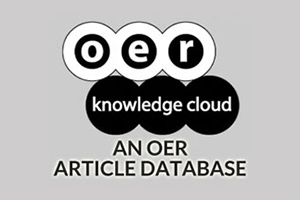Evaluating AI-Personalized Learning Interventions in Distance Education
DOI:
https://doi.org/10.19173/irrodl.v26i1.7813Keywords:
learner agency, adaptive technology, micro-learning, disruptive innovation, distributed learningAbstract
This study aimed to evaluate the utility of artificial intelligence (AI) in improving the persuasive communication skills of online Master of Business Administration (MBA) students. In particular, this study investigated the influence of personalization through AI using the Google Gemini platform on conventional and online instructional approaches. This quasi-experimental study used a pretest and posttest design to compare two groups of MBA students pursuing persuasive online communication. The experimental group (n = 32) interacted with the AI-based personalized learning materials, whereas the control group (n = 32) used standard instructor-designed online modules. During the 12-week intervention period, the experimental group was provided with customized practice activities. Conversely, the control group was offered conventional online learning material. The effectiveness of both approaches was evaluated using pretests and posttests. The results of Tukey’s Honestly Significant Difference (HSD) test provided insight into the areas where AI-based personalized learning had a statistically significant impact. These results support the conclusions derived from an analysis of variance and further validate the study’s research hypotheses. This study demonstrates the advantages of incorporating AI into language development for remote learners and offers valuable insights for integrating AI-driven technologies into distance education.
References
Andrade, H. G. (2000). Using rubrics to promote thinking and learning. Educational Leadership, 57(5), 13–19.
Chen, X., Zou, D., Cheng, G., & Xie, H. (2021, July 1). Artificial intelligence-assisted personalized language learning: Systematic review and co-citation analysis. In M. Chang, N.-S. Chen, D. G. Sampson, & A. Tlili (Eds.), Proceedings: IEEE 21st International Conference on Advanced Learning Technologies (ICALT) (pp. 241–245). https://doi.org/10.1109/ICALT52272.2021.00079
Chiu, T. K. F., Moorhouse, B. L., Chai, C. S., & Ismailov, M. (2023, February 6). Teacher support and student motivation to learn with Artificial Intelligence (AI) based chatbots. Interactive Learning Environments, 1–17. https://doi.org/10.1080/10494820.2023.2172044
Chiu, T. K. F., Xia, Q., Zhou, X., Chai, C. S., & Cheng, M. (2023). Systematic literature review on opportunities, challenges, and future research recommendations of artificial intelligence in education. Computers and Education: Artificial Intelligence, 4, Article 100118. https://doi.org/10.1016/j.caeai.2022.100118
Crawford, J., Cowling, M., & Allen, K.-A. (2023). Leadership is needed for ethical ChatGPT: Character assessment and learning using artificial intelligence (AI). Journal of University Teaching & Learning Practice, 20(3), Article 02. https://doi.org/10.53761/1.20.3.02
Crompton, H., & Burke, D. (2023). Artificial intelligence in higher education: The state of the field. International Journal of Educational Technology in Higher Education, 20(1), Article 22. https://doi.org/10.1186/s41239-023-00392-8
DiBenedetto, M. K., & Bembenutty, H. (2011). Differences between full-time and part-time MBA students’ self-efficacy for learning and for employment: A self-regulatory perspective. The International Journal of Educational and Psychological Assessment, 7(1), 81–110. https://www.researchgate.net/publication/281466153_Differences_between_full-time_and_part-time_MBA_students'_self-efficacy_for_learning_and_for_employment_A_self-regulatory_perspective
Francis, R. (2012). Business communication courses in the MBA curriculum: A reality check (Corpus ID: 56263598). Semantic Scholar. https://www.semanticscholar.org/paper/Business-Communication-Courses-in-the-MBA-A-Reality-Francis/ebc9594a269889c3c14e91edd8d075c52676fd6b
Huang, X., Zou, D., Cheng, G., Chen, X., & Xie, H. (2023). Trends, research issues and applications of artificial intelligence in language education. Educational Technology & Society, 26(1), 112–131. https://www.jstor.org/stable/48707971
Istenič, A. (2021). Online learning under COVID-19: Re-examining the prominence of video-based and text-based feedback. Educational Technology Research and Development, 69(1), 117–121. https://doi.org/10.1007/s11423-021-09955-w
Jadhav, S. V., Shinde, S. R., Dalal, D. K., Deshpande, T. M., Dhakne, A. S., & Gaherwar, Y. M. (2023). Improve communication skills using AI. In P. B. Mane & A. R. Buchade (Chairs), Proceedings of the 2023 International Conference on Emerging Smart Computing and Informatics (ESCI) (pp. 1–5). IEEE. https://doi.org/10.1109/ESCI56872.2023.10099941
Liang, J.-C., Hwang, G.-J., Chen, M.-R. A., & Darmawansah, D. (2021). Roles and research foci of artificial intelligence in language education: An integrated bibliographic analysis and systematic review approach. Interactive Learning Environments, 31(7), 4270–4296. https://doi.org/10.1080/10494820.2021.1958348
Liu, C., Hou, J., Tu, Y.-F., Wang, Y., & Hwang, G.-J. (2021). Incorporating reflective thinking promoting mechanism into artificial intelligence-supported English writing environments. Interactive Learning Environments, 31(9), 5614–5632. https://doi.org/10.1080/10494820.2021.2012812
Long, S., & McLaren, M.-R. (2024). Belonging in remote higher education classrooms: The dynamic interaction of intensive modes of learning and arts-based pedagogies. Journal of University Teaching and Learning Practice, 21(2), Article 03. https://doi.org/10.53761/1.21.2.03
Lund, B. D., Wang, T., Mannuru, N. R., Nie, B., Shimray, S., & Wang, Z. (2023). ChatGPT and a new academic reality: Artificial Intelligence‐written research papers and the ethics of the large language models in scholarly publishing. Journal of the Association for Information Science and Technology, 74(5), 570–581. https://doi.org/10.1002/asi.24750
Maghsudi, S., Lan, A., Xu, J., & van der Schaar, M. (2021). Personalized education in the artificial intelligence era: What to expect next. IEEE Signal Processing Magazine, 38(3), 37–50. https://doi.org/10.1109/msp.2021.3055032
McGraw, P., & Tidwell, A. (2001). Teaching group process skills to MBA students: A short workshop. Education + Training, 43(3), 162–171. https://doi.org/10.1108/EUM0000000005461
Moskal, B. M. (2000). Scoring rubrics: What, when, and how? Practical Assessment, Research, and Evaluation, 7(3). https://doi.org/10.7275/a5vq-7q66
Obari, H., Lambacher, S., & Kikuchi, H. (2020). The impact of using AI and VR with blended learning on English as a foreign language teaching. In F. Karen-Margrete, L. Sanne, B. Linda, & T. Sylvie (Eds.), CALL for widening participation: Short papers from EUROCALL 2020 (pp. 253–258). Research-publishing.net. https://doi.org/10.14705/rpnet.2020.48.1197
Ongus, R. W., Gekara, M. M., & Nyamboga, C. M. (2017). Library and information service provision to part-time postgraduate students: A case study of Jomo Kenyatta Memorial Library, University of Nairobi, Kenya. Journal of Information and Knowledge, 54(1), 1–17. https://doi.org/10.17821/srels/2017/v54i1/108529
Paterson, C., Paterson, N., Jackson, W., & Work, F. (2020). What are students’ needs and preferences for academic feedback in higher education? A systematic review. Nurse Education Today, 85, Article 104236. https://doi.org/10.1016/j.nedt.2019.104236
Palincsar, A. S., & Herrenkohl, L. R. (2002). Designing collaborative learning contexts. Theory Into Practice, 41(1), 26–32. https://doi.org/10.1207/s15430421tip4101_5
Randolph, W. A. (2008). Educating part-time MBAs for the global business environment. Journal of College Teaching & Learning (TLC), 5(8). https://doi.org/10.19030/tlc.v5i8.1236
Sánchez-Villalon, P. P. S., & Ortega, M. (2007). AWLA and AIOLE for personal learning environments. International Journal of Continuing Engineering Education and Life-Long Learning, 17(6), 418–431. https://doi.org/10.1504/IJCEELL.2007.015591
Shadish, W. R., Cook, T. D., & Campbell, D. T. (2002). Experimental and quasi-experimental designs for generalized causal inference. Houghton Mifflin.
Shevchenko, V., Malysh, N., & Tkachuk-Miroshnychenko, O. (2021). Distance learning in Ukraine in COVID-19 emergency. Open Learning: The Journal of Open, Distance and E-Learning, 39(1), 4–19. https://doi.org/10.1080/02680513.2021.1967115
Suen, H.-Y., Hung, K.-E., & Lin, C.-L. (2020). Intelligent video interview agents used to predict communication skill and perceived personality traits. Human-Centric Computing and Information Sciences, 10(1), Article 3. https://doi.org/10.1186/s13673-020-0208-3
Tomasik, M. J., Helbling, L. A., & Moser, U. (2020). Educational gains of in‐person vs. distance learning in primary and secondary schools: A natural experiment during the COVID-19 pandemic school closures in Switzerland. International Journal of Psychology, 56(4), 566–576. https://doi.org/10.1002/ijop.12728
Wang, J., & Mendori, T. (2012). A customizable language learning support system using course-centered ontology and teaching method ontology. In T. Matsuo, K. Hashimoto, & S. Hirokawa (Eds.), 2012 IIAI International Conference on Advanced Applied Informatics (pp. 149–152). IEEE. https://doi.org/10.1109/IIAI-AAI.2012.38
Wang, X., Liu, Q., Pang, H., Tan, S. C., Lei, J., Wallace, M. P., & Li, L. (2023). What matters in AI-supported learning: A study of human-AI interactions in language learning using cluster analysis and epistemic network analysis. Computers & Education, 194, Article 104703. https://doi.org/10.1016/j.compedu.2022.104703
Zhao, X. (2022). Leveraging artificial intelligence (AI) technology for English writing: Introducing Wordtune as a digital writing assistant for EFL writers. RELC Journal, 54(3), 890–894. https://doi.org/10.1177/00336882221094089
Published
How to Cite
Issue
Section
License

This work is licensed under a Creative Commons Attribution 4.0 International License.
This work is licensed under a Creative Commons Attribution 4.0 International License. The copyright for all content published in IRRODL remains with the authors.
This copyright agreement and usage license ensure that the article is distributed as widely as possible and can be included in any scientific or scholarly archive.
You are free to
- Share — copy and redistribute the material in any medium or format
- Adapt — remix, transform, and build upon the material for any purpose, even commercially.
The licensor cannot revoke these freedoms as long as you follow the license terms below:
- Attribution — You must give appropriate credit, provide a link to the license, and indicate if changes were made. You may do so in any reasonable manner, but not in any way that suggests the licensor endorses you or your use.
- No additional restrictions — You may not apply legal terms or technological measures that legally restrict others from doing anything the license permits.







